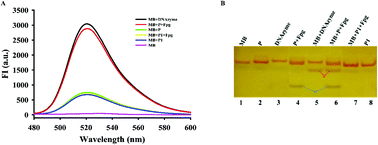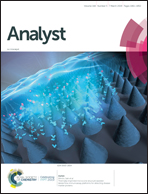A cascade amplification platform assisted with DNAzyme for activity analysis, kinetic study and effector screening of Fpg in vitro†
Abstract
As a highly conserved damage repair protein, Fpg can specifically recognize and digest 8-oxoG from a damaged DNA backbone. Meanwhile, DNAzyme, a single-stranded DNA with enzymatic activity, can cleave RNA in the presence of cofactors. In this study, we established a highly sensitive method for Fpg assay using a DNAzyme-mediated signal cascade amplification strategy. Based on the Fpg-dependent fluorescence response of the “turn-on” manner, we could reliably determine Fpg activity down to 0.14 U mL−1 with a linear response from 0.10 to 40 U mL−1 under optimal conditions. In addition, this strategy was successfully applied to analyze the kinetic parameter of Fpg with Km of 0.061 μM. Furthermore, the developed sensing system was used to screen the regulators of Fpg from natural compounds and antibiotics. These results indicated that all of the 14 natural compounds and 6 kinds of antibiotics deferentially showed an active effect on Fpg in vitro. In summary, these results show that the method not only provides an alternative for monitoring Fpg activity but also shows great potential for drug screening in the future.



 Please wait while we load your content...
Please wait while we load your content...